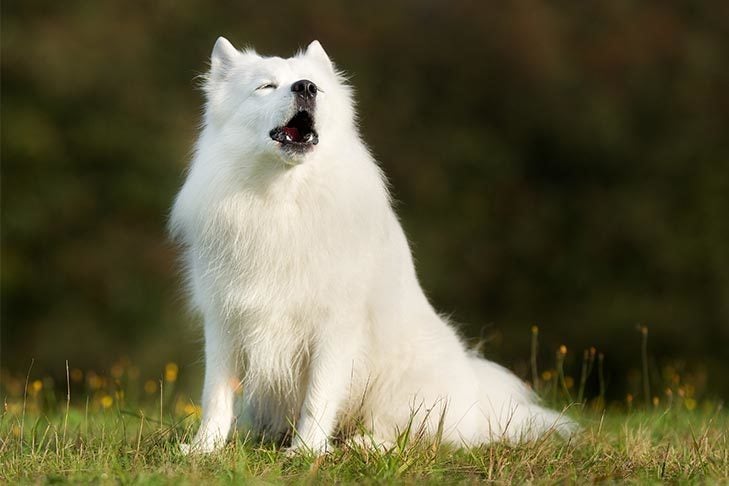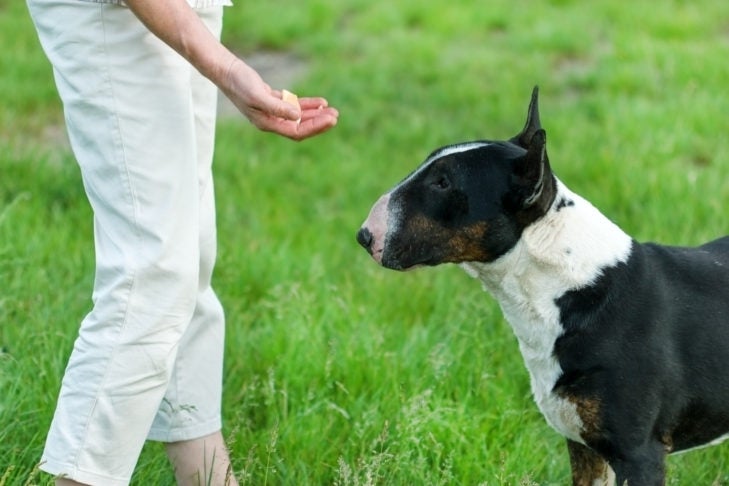
Dogs bark. It’s a fact of life that nearly all dog owners must accept. Barking is a self-rewarding behavior. But it is important for breeders and kennel owners to understand the different types of barking, and when it has turned into a problem behavior.
Canine Sounds & What They Mean
A bark or vocalization is not just a bark or a vocalization. A dog owner, breeder, or kennel manager who knows their dogs and has a keen sense of hearing and awareness can tell you that each dog’s voice is unique. Additionally, many movements made by dogs are attempts to communicate with you or other dogs. How they hold their head, mouth, eyes, and tail are all deliberate.
The speed of movement and how the dog makes these movements also matter. Understanding both canine sounds and movements can help you better communicate with and learn from your dogs.
Howl
You may notice that different breeds, sizes, and shapes of dogs bark differently. For instance, Siberian Huskies, Alaskan Malamutes, and other northern breeds can bark, but they often howl or “sing” alone or together. It is believed that they do this because their ancestors and/or distant relatives howled. They may have done this to communicate with pack members near their location, status, or territory areas.
Sometimes, dogs who howl do so to communicate that they are stressed, have anxiety, or if they are in pain or uncomfortable. Often a howl can be in response to a siren, musical instrument, or a person singing. It is not uncommon for the Arctic breeds to howl before their eyes are even open as puppies.
Bay, Tree & Chop

Scenthounds like Beagles, Bloodhounds, and Bluetick Coonhounds, to name a few, are known to “bay.” This may sound like a howl, but the excitement level, depth, and purpose of the sound are very different. The bay often sounds like a long, carried–out bark with a special depth to it. The dog that bays is often on the move and announcing that they are on track or chasing a rabbit, raccoon, or other animal. You will notice the dog’s excitement level rise. The bay changes to a “tree” or “chop” bark when the dogs have an animal cornered or “treed.” This bark is called a chop because of its short sharp and repetitive sound.
Growls
A growl often indicates a threat, but it can have a variety of meanings. Deep continuous growls are described as “rumbles.” Sometimes you can feel the rumble if you are touching or standing near the dog. A long deep rumble is often a sign that a dog is asking for space, and that should be given.
A broken growl may indicate fear, which can be even more dangerous for other dogs, animals, or people. When dogs feel trapped, they will run away if they can (“flight). If a dog cannot run away, it may choose to “fight.” The last thing a trapped dog may do is freeze. If you try to pick up or move a dog frozen in fear, they may turn on you. Be very careful with dogs who are frozen in fear. Work slowly and in a positive manner to gain their trust.
Always watch a growling dog to see if it is coming towards you or retreating. But keep in mind their direction can change in an instant. If you have a dog that growls or acts reactively, especially unprovoked, seriously consider removing this dog from your breeding program. Try to learn why this dog is behaving this way. If this is a new behavior, consider that something may be wrong with the pup.
Breed-Specific Sounds
There are several breeds that have unique behaviors and vocalization combinations. For instance, the Nova Scotia Duck Tolling Retriever was bred to imitate the curious activity of foxes, whose color and quick movements exert a strange fascination over waterfowl. The sight of a Toller playing fetch along the shoreline arouses the curiosity of ducks offshore. Tollers often bark in a very high, excited, and shrill short burst that sounds much like the quacking or “call” of some waterfowl. These traits bring the ducks within the reach of a hunter’s gun.
Another breed with a unique vocalization is the Basenji. It is known as the African barkless dog, but barkless does not mean mute. The cry made by a Basenji is occasionally compared to the wails of a crying child.
Chortle
Another somewhat odd vocalization of note is known as a chortle. It can be described as a mouthy, breathy chuckle sound made by a dog. Basenjis, Boston Terriers, and French Bulldogs are some of the breeds that make this unique and often high-pitched sound. This vocalization can be made by a gleeful dog, one in extreme distress, or during a tussle between dogs.
Body language, intensity, volume, and pitch will help you decide if the dog is having fun, trying to talk you out of a treat, or if it is in distress.
“A-Roo”
A similar sound to a chortle is an “a-roo.” Whippets, Greyhounds, and Boxers are a few of the breeds that make this sound. It may sound like a chortle, but deeper and not as shrill.
Sighs, Whimpers, Whines, & Yelps
These are sounds that you need to pay attention to in the kennel. A sigh can be a dog giving into you or another dog as a sign of submission. It can also be the exhaling of a deep breath as the dog lies down for a nice long nap. If your dogs are whimpering, whining, shivering, shaking or facing away, it signals that something is wrong, upsetting, or very stressful. In these cases, seek veterinary attention promptly.
Whining can also mean the dog is seeking attention, but their body language may be completely different. It is likely they will be pushing your hand with their nose for some extra cuddle time or staring directly at you, especially when you have food.
A yelp is likely to mean a dog is hurt. If it is a short, sharp and sudden high-pitched yelp, it is likely someone may have nipped that dog or puppy too hard. This is the way puppies tell the others “Hey, not so hard!” If it is a long, drawn–out, and repeating shriek, that is a distress call and you need to get help quickly.
Barking In Kennels
Once you’ve learned more about different canine sounds and what they mean, you can address the issue of dogs barking in kennels. One main reason is stress. Dogs who do not get enough exercise are stressed dogs. Stressed dogs are not happy dogs. Unhappy dogs are loud dogs, and loud dogs don’t make the neighbors happy. If you are a breeder and your dogs are excessively barking, this means stress, and stress means lower productivity.
You can’t just listen to a dog barking and know everything that is going on in your kennel. You must also look at the dog’s body language to determine what kind of barking is happening and why.
Fear Bark
A high-pitched fear bark often entails rapid barks accompanied by the dog bouncing in a backward motion away from what has startled or scared them. It is likely their front feet will be out in front of them as they bounce back. Usually, their hackles are raised to create the illusion that they are larger than they really are.
Alarm Bark
A classic alarm bark is two to four rapid barks, one after another, with a pause in between. Dogs will give this bark when they think there is something going on, and there is a need to tell everyone. The alarm bark may sound similar to a fear bark. However, it is normally an octave or two lower, and continuous.
Dogs often settle down from an alarm bark to a classic greeting when they recognize someone they know and trust.

Greeting Bark
The classic greeting bark is one to two barks at a higher pitch. This may happen when the kennel owner or a familiar worker comes into the kennel. The dogs should then settle and quiet on their own. Often, what happens is the kennel owner or worker comes into the kennel, and the dogs in the first two to four runs can see them. Those dogs bark and this causes all the dogs in the kennel to bark.
Since none of the dogs past the first few runs can see what is happening, they assume it must be bad, so they elevate their barking and keep the entire kennel excited, loud, and stressed.
Solutions for A Quieter Kennel
So, what is the solution to barking dogs in a kennel? Dogs that excitedly jump up and down and yip, screech, and bark can be taught to be quiet and calm. But, it will take some work. It is not going to happen overnight, and you must be consistent and calm, and speak softly. Maintaining certain rules can help you achieve a quieter kennel.
- Don’t yell at your dogs. Do not yell at the dogs to “BE QUIET!” or they will think, “Yippee, he is barking with us!” or “There really must be something scary out there, because he is barking too!”
- Exercise your dogs. A tired dog is a quiet dog. Exercise reduces stress in humans and dogs. Regularly exercising your dogs is the very best noise reduction tool, and can contribute to a quieter kennel.
- Don’t put barkers near entry doors. Put shy dogs near the entry doors. That way, they can see what is going on and get used to the higher levels of activity.
- Ensure every dog has a view of the entry and exit. Make your kennel a hexagon or an open “V” shape with the main door on the wide side of the room. This will allow all the dogs to see the doors as people enter and exit.
- Make sure dogs can see out of their runs. Use materials that allow the dogs to easily see you. They will be quieter if they can see what you are doing and who is coming and going in the kennel.
- Offset kennel run doors. If you have a long row of kennels across from each other, make sure the doors are not straight across from each other. Offset the run doors, so the dogs cannot directly see the dog across from them. Offsetting each pen will help stop fence fighting, and they are less likely to bark at one another.
- Never approach a dog that is barking or out of control. Doing so could inadvertently reward bad behavior by focusing attention on it.
- Use high-value treats & reward good behavior. Use rewards your dogs really like. Always have a pocket of treats or fast access to the treat. You only have a short time to say “yes” when the dog stops barking and give it a reward. Otherwise, it will not know why it is being rewarded. Use positive reinforcement with treats, toys, praise, and touch.
- Teach the benefits of a quieter kennel: Never give a treat to a barking dog, but when you see one of your “barkers” being quiet, even for a half-second, say “yes” and hand the reward to them. Remember to mix your rewards up. Some dogs like a special toy, praise, or to be touched better than a treat.
More Tips and Tricks To Keep The Peace
Gradually, increase the time that the dogs must be quiet. Start with a half-second, then extend it to two seconds, then three seconds, then five seconds. By the end of the third day, your barkers should be understanding that you will not approach their pen if they are barking. And you certainly won’t give them a reward or treat if they are barking.
If your barkers just won’t take a breath, turn your back on them and stand there. If they quiet for half a second, immediately turn around say “yes,” and give them a treat or reward. Then move on, and do not linger.
If you are doing chores and you notice a barker is being quiet, say “yes,” and give them a treat. If you don’t have a treat close by, open the pen and love on them for a minute. They will quickly learn that you will give them attention when they are quiet.

Change up your reward from time to time. One time give a treat. The next time, give some praise, a cuddle, or a toy they really like. If you have a dog who will not approach you, use a sticky treat like cream cheese or cheese from a can and smear it on the wall when the dog is quiet. Each time you reward the dog, you want to see a slight improvement or a longer quiet period. If you don’t ask for more from the dogs, you won’t get better behavior.
Put a dog who will not take a treat from your hand into a run with one who will. This will help the shy dog learn taking a treat from your hand is okay. Try not to make eye contact with the shy dog.
Lastly, always attempt to be calm, quiet, and consistent. Before you know it, you will have a quieter kennel that is calm, friendly, and socially enriched.
Stacy Mason is a Senior Breeder Field Representative with the American Kennel Club.

